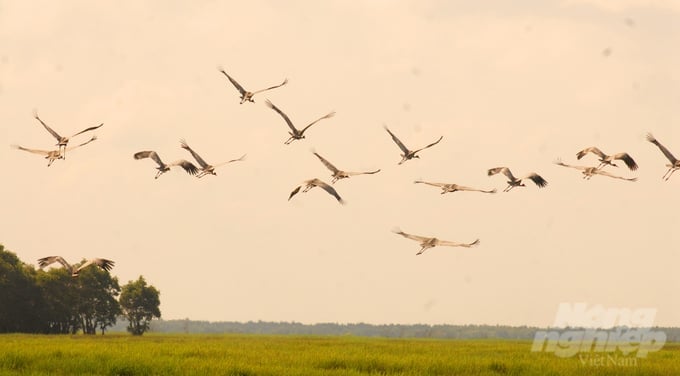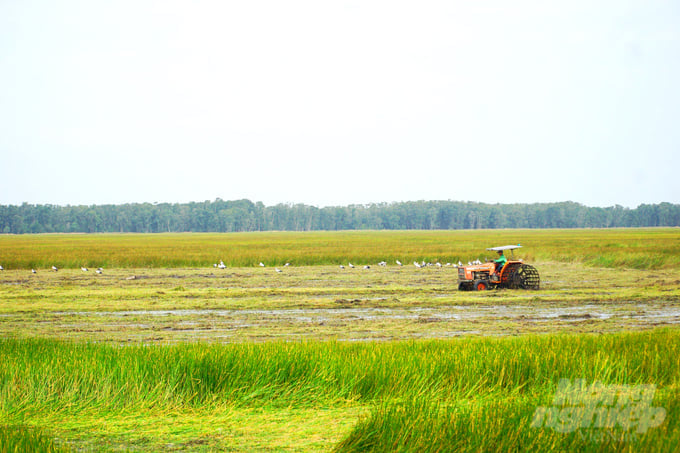June 21, 2025 | 01:46 GMT +7
June 21, 2025 | 01:46 GMT +7
Hotline: 0913.378.918
June 21, 2025 | 01:46 GMT +7
Hotline: 0913.378.918

Tram Chim National Park in Tam Nong district, Dong Thap province. Photo: Le Hoang Vu.
The general objective of the project is to restore and develop the red-crowned crane population at Tram Chim National Park in Tam Nong district by nurturing and releasing the cranes into their natural habitat.
Over the course of ten years between 2022 and 2032, the project aims to nurture and release 100 red-crowned cranes, with a minimum of 50 individuals expected to survive. The released red-crowned cranes are anticipated to reproduce naturally, thrive in the wild, and establish year-round residency in Tram Chim National Park.
Dong Thap province is scheduled to receive 30 six-month-old cranes from Thailand between 2022 and 2028 for nurturing, care, and subsequent release into their natural habitat. The infrastructure, including breeding facilities, will be completed to support the implementation of the entire process.
The ecosystem of Tram Chim National Park will be restored through the logical regulation of water and the application of suitable research measures to serve the habitat of the red-crowned crane population at Tram Chim National Park.
The project outlines a roadmap through 2028, during which approximately 200 hectares of rice fields in the buffer zone of Tram Chim National Park will be converted to an ecological production model, with a focus on organic agriculture practices in the vicinity of Tam Nong district. Within the first five years, the environment is expected to support successful reproduction and natural habitation of red-crowned cranes at Tram Chim National Park.

Land rehabilitation for the habitation of cranes. Photo: Le Hoang Vu.
Subsequently, Dong Thap province will continue negotiations with Thailand to receive an additional 30 six-month-old cranes between 2029 and 2032. Accordingly, the province will nurture and breed approximately 40 crane individuals from the original parental flock.
On the other hand, a distribution chart will be established for red-crowned cranes inside and outside Tram Chim National Park. The park's technical staff will be assigned to the care and breeding of red-crowned cranes, as well as their subsequent release into the natural habitat. Additionally, local farmers living in the buffer zone of Tram Chim National Park will be encouraged to engage in both agriculture and eco-tourism activities involving red-crowned cranes.
The total cost for the implementation of the red-crowned crane conservation project is estimated at nearly 185 billion Vietnamese dong, which includes 56 billion Vietnamese dong allocated for the reception, nurturing, reproductive research, and release of crane flocks. Approximately 25 billion Vietnamese dong will be allocated for the restoration and rehabilitation of the ecosystem within Tram Chim National Park. Additionally, 36 billion Vietnamese dong will be allocated for the development of a sustainable ecological agricultural production model, 17 billion Vietnamese dong for communication efforts, and 52 billion Vietnamese dong for infrastructure investment.

Over the course of ten years between 2022 and 2032, the project aims to nurture and release 100 red-crowned cranes, with a minimum of 50 individuals expected to survive. Photo: Tram Chim National Park.
The announcement ceremony of the Project for the conservation and development of red-crowned crane at Tram Chim National Park in Dong Thap province is scheduled to take place in late 2023.
Mr. Le Quoc Phong, Secretary of Dong Thap Provincial Party Committee, accompanied by various local departments and agencies, Tam Nong District People's Committee, and Tram Chim National Park, conducted a survey to assess the progress of the conservation and development of red-crowned crane at Tram Chim National Park.
Mr. Le Quoc Phong urged Tram Chim National Park to promptly finalize all legal procedures related to the reception of red-crowned cranes, seek expert opinions for detailed plans regarding transportation and local care for the cranes. Furthermore, he requested close coordination among agencies and units to expedite the completion of assigned tasks, enhance technical infrastructure, and facilitate the announcement ceremony of the Project for the conservation and development of red-crowned crane at Tram Chim National Park.

Secretary of Dong Thap Provincial Party Committee Le Quoc Phong (right), conducting a survey of the ecological rice fields in the buffer zone of Tram Chim National Park. Photo: Le Hoang Vu.
Additionally, Mr. Le Quoc Phong has instructed Dong Thap province's Department of Agriculture to closely coordinate with Tram Chim National Park in monitoring and ensuring the completion of all construction and technical infrastructure projects in compliance with the schedule. He has also urged the Tam Nong district People's Committee to expedite the improvement of transportation infrastructure, thereby ensuring convenience and mobility for the upcoming announcement ceremony of the Project for the conservation and development of red-crowned crane at Tram Chim National Park.
The rediscovery of the red-crowned crane at Tram Chim dates back to 1985. The recorded number of cranes at Tram Chim once exceeded 1,000 individuals (1,058 individuals in 1988). By the late 1990s, Tram Chim consistently housed the largest population of red-crowned cranes in the downstream Mekong River region. The presence of the red-crowned crane was one of the significant reasons for the establishment of the Tram Chim Flooded Forest Conservation Area, the precursor to present day's Tram Chim National Park. However, due to a number of reasons, the number of red-crowned cranes returning to Tram Chim has gradually declined over time.
Translated by Nguyen Hai Long
![Turning wind and rain into action: [9] Digitizing hydrometeorological data in response to climate change](https://t.ex-cdn.com/nongnghiepmoitruong.vn/608w/files/news/2025/06/17/z6704423696987_15fd32ffc26d590d204d520c9dac6786-nongnghiep-165943.jpg)
(VAN) Farmers have begun accessing hydrometeorological applications to adjust their cropping schedules, aiming to ensure productivity and adapt to climate change.
![Turning wind and rain into action: [8] Real-time salinity detection and early warning technology](https://t.ex-cdn.com/nongnghiepmoitruong.vn/608w/files/news/2025/06/17/z6704423696987_15fd32ffc26d590d204d520c9dac6786-nongnghiep-151127.jpg)
(VAN) Thanks to the integration of modern hydrological-hydraulic models, remote sensing technologies, and artificial intelligence, the accuracy of hydrological forecasting has significantly improved.
![Turning wind and rain into action: [7] Early disaster warnings help marine farmers minimize losses](https://t.ex-cdn.com/nongnghiepmoitruong.vn/608w/files/news/2025/06/17/z6704423696987_15fd32ffc26d590d204d520c9dac6786-nongnghiep-142942.jpg)
(VAN) In recent years, thanks to early disaster warnings and forecasting, marine farmers in Khanh Hoa province have been able to reduce risks and losses, thereby improving production efficiency.
![Turning wind and rain into action: [6] ‘Four on-the-spot’ disaster management software](https://t.ex-cdn.com/nongnghiepmoitruong.vn/608w/files/news/2025/06/17/e5a48259d6a262fc3bb3-nongnghiep-183800.jpg)
(VAN) By simply activating the scenario on the disaster management software, the relevant authorities immediately know how many households need to be evacuated, where to evacuate them to, and by what means of transportation…
![Turning wind and rain into action: [5] Hue applies modern technology in disaster forecasting](https://t.ex-cdn.com/nongnghiepmoitruong.vn/608w/files/news/2025/06/17/z6704423696987_15fd32ffc26d590d204d520c9dac6786-nongnghiep-093938.jpg)
(VAN) In Hue city, modern technology has recently been applied in meteorological and hydrological forecasting and warning, helping to reduce the damage caused by natural disasters.

(VAN) A cutting-edge farming technique being implemented on an experimental ranch in Arizona's Sonoran Desert has already saved a billion gallons of water over five years, according to Civil Eats.

(VAN) Poultry and pig production and the environment can be boosted through enhanced water technology, according to new research.